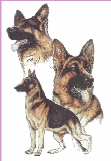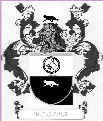BREED HISTORY:
GSD History: The German Shepherd Dog is respected and admired throughout the world for its versatility, intelligence, and loyalty. It has existed as a recognized breed for a relatively brief period of time compared to other dog breeds. The early shepherd dogs of Germany were of several types suited to their environments. Coat length and texture, color, and build all varied but these types all possessed ruggedness, intelligence, soundness, and the ability to do specialized work.
With advances in transportation and communication came the forming of societies of herders and the first trends toward selective breeding of herding dogs, record keeping, and a gradual trend toward one type of dog which could work equally well under all conditions. In 1881, the first formal club, the "Phylax" society was formed but lasted only about three years.
In 1889 Captain Max von Stephanitz began the standardization of the breed. It all started at a dog show in Karlsruhe in western Germany. A medium-sized yellow-and-gray wolflike dog caught his attention. The dog was of the primal canine type, supple and powerful, and possessed endurance, steadiness, and intelligence. He was a working sheepherder, born with this ability, requiring no training other than direction and finish to become proficient at the task. This dog, Hektor Linksrhein, was purchased by von Stephanitz, renamed Horand von Grafrath, and became the first registered German Shepherd Dog.
Von Stephanitz founded the Verein für Deutsche Sch·ferhunde, SV (German Shepherd Dog Club), becoming the first president, and in a short period of time achieved the standardization of form and type in the breed. A standard was developed based on mental stability and utility. The captain's motto was "Utility and intelligence". To him beauty was secondary, and a dog was worthless if it lacked the intelligence, temperament, and structural efficiency that would make it a good servant of man. A breed standard was developed as a blueprint dictating the exact function and relationship of every aspect of structure, gait, and inherent attitude.
Von Stephanitz inbred heavily on Horand and also Luchs, his brother, to consolidate the bloodline. Horand's best son, Hektor von Schwaben, the second German Sieger, was mated with his half-sister as well as through daughters of his own sons, Beowulf, Heinz von Starkenberg, and Pilot III.
Intense inbreeding also concentrated undesirable recessive originating from the mixing of the original strains. Von Stephanitz then inserted unrelated blood of herding origin through Audifax von Grafrath and Adalo von Grafrath.
As Germany became increasingly industrialized and the pastoral era declined, von Stephanitz realized the breed might also decline. With the co-operation of police and working dog clubs a set of specific tests was developed in tracking, formal obedience, and protection work. This was the prototype of the present Schutzhund trials. He persuaded the authorities to utilize the German shepherd dog in various branches of government service. The dog served during the war as Red Cross dogs, messenger dogs, supply carriers, sentinel, tracking and guard dogs.
The German Shepherd is considered as one of the most elegant and noble breed of dogs. With its high pointing ears and shiny coats, the strong and agile appearance of these dogs are only preceded by their intelligence. These dogs learn quickly and will never forget what was taught to them. Because they are hardworking and active, German Shepherds are also praised for their capability to do work. But just where did this breed come from? And how did this breed attain the reputation that it has now?
Though there were high risks in having defective offsprings, inbreeding was necessary to permanently fix the qualities during the early years of the German Shepherds. In order to keep the breed alive, Von Stephanitz had to find other uses for the breed aside from regular sheep herding. He soon realized that the abilities of the breed can be very helpful for government activities. During the two world wars, the German Shepherd has gained much praise from their owners for being a very brave and reliable companion in the field. It is for these reasons that the breed has become one of the most popular breeds in the world.
After the second world war, the name of the breed was changed for certain reasons. From the German Shepherd it became the Alsatian wolf dog which was named after the German-French border Alsace-Lorraine. But in 1977, the original name of the breed German Shepherd Dog was returned and is currently used in most countries.














